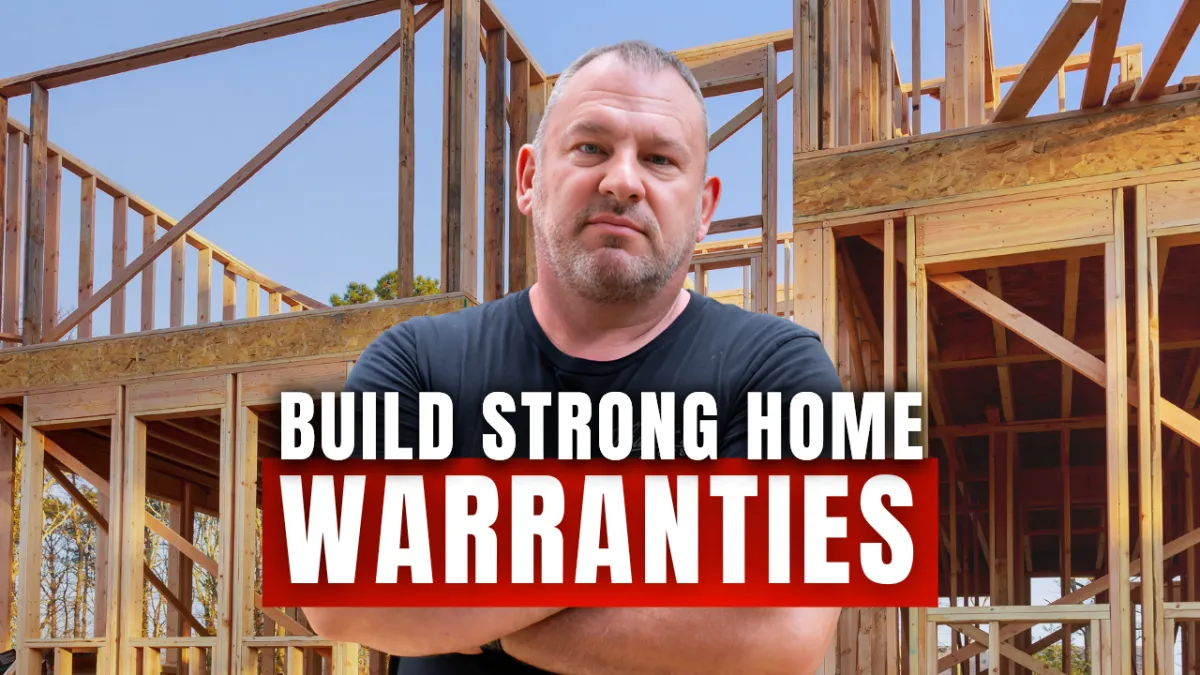
How to Create Effective Home Builder Warranties That Actually Grow Your Business
You’re Probably Wasting Money on Your Warranty (Or Losing Sales Because of It)
Nearly 70 percent of homeowners don’t understand their warranty, and most builders don’t either. They either copy some generic legal doc off the internet or make it so restrictive that no one feels protected. Both options cost you money. And if you're using your own cash on every build, struggling to close deals, and wondering why trust is hard to build with clients, your warranty might be the silent killer in your business.
The right warranty does three things:
Protects your business legally
Builds buyer confidence
Helps you close more deals and command premium pricing
Let’s break down the exact system to make it happen.
Why Most Builder Warranties Are Costing You Deals
You’re either using something you found online or trying to cover as little as possible. That’s not a system. That’s fear. Buyers notice. When you hand over a vague document and can’t explain what’s covered, you look unprepared and unprofessional.
A strong warranty:
Shows confidence in your work
Demonstrates your process
Separates you from every low-budget competitor in your market
One of my clients used our warranty system to close three builds in a single week because it made his process look bulletproof.
Know Your Risk Profile Before You Write a Single Line
Every builder wants to avoid risk, but few take time to understand where it actually is. Here’s how to break it down:
Structural Risks: Low probability, high cost (foundations, framing, etc.)
Systems Risks: Medium impact (HVAC, plumbing, electrical)
Finish Risks: High frequency, lower cost (paint, floors, fixtures)
Process Risks: Delays, communication failures, change order disputes
If you’re constantly getting claims in one category, it's not bad luck. It's bad systems. Fix the source, not just the symptom.
Your Warranty Coverage Framework: Do This Right
Here’s a proven structure that protects you and sells more homes.
Coverage Duration
1 year comprehensive
2 years major systems
10 years structural (clearly defined)
Clear Scope
List exactly what’s covered
Define what isn’t
Response Process
Acknowledge claims within 24 hours
Schedule inspection within 48
Communicate next steps clearly
Contractor Network
Your warranty is only as good as your subcontractors
Include key contact info for transparency
Legal Protection: What Most Builders Miss
You’re not just protecting the client. You’re protecting your company. That means including:
Your state’s warranty minimums
Limitation of liability clauses
Right to repair before anyone else touches the issue
Transfer rights (great resale value for buyers)
Arbitration clause to keep disputes out of court
Skip this, and a $500 repair becomes a $15,000 disaster real fast.
Turn Your Warranty into a Sales Weapon
This is where most builders blow it. The warranty gets handed over at closing, never mentioned during the sales process. That’s a missed opportunity.
Instead, do this:
Walk the client through the warranty during the sales presentation
Use it to position yourself against weak competition
Communicate the value clearly ("This level of protection would cost $3K to $5K if purchased separately")
Share real success stories
Focus on peace of mind, not just problem solving
I had one client refer four families because of how well I handled a heating issue. That’s not luck. That’s systemized follow-through.
Implementation: Where Most Builders Fail
It’s not enough to have a great document. You need to follow through with:
A warranty orientation at closing
Regular follow-ups at 30 days, 6 months, and 11 months
A consistent claim process with documentation
A CRM or spreadsheet that tracks every interaction
Use claim patterns to improve your materials, contractors, and systems
This builds trust, shows professionalism, and drives referral business.
Advanced Strategies to Build Long-Term Value
Once your warranty is dialed in, take it further with:
Tiered Warranties: Offer a premium plan with added benefits
Partner Discounts: Work with vendors to offer post-warranty support
Preventative Maintenance Programs: Optional, but adds value
Tech Integration: Use a CRM or platform to manage claims professionally
Warranty Transfers: Let the warranty carry over for resales
All of these make your warranty stand out, create new revenue opportunities, and build long-term trust with clients.
Avoid These Common Warranty Mistakes
If you're doing any of the following, it’s time to course correct:
Copying someone else’s template
Overpromising coverage you can’t deliver
Being so restrictive that clients don’t feel protected
Failing to explain your warranty clearly
Ignoring follow-up and service
Not tracking claims
Thinking a warranty replaces your insurance
None of this helps your reputation or your bottom line.
Ready to Fix Your Warranty System?
If your warranty is costing you deals or causing client headaches, it’s time to fix it. You need a clear, professional, and profitable warranty system that:
Protects your business
Builds client trust
Helps you close more deals at higher prices
If you're serious about becoming the builder everyone trusts, schedule a free Zoom strategy call with me.
We’ll look at your current process, your market, and build a roadmap that fits your business.
